Past Meets Present: Discover the Stunning Transformations of Age-Old Spots

You know how you spot a childhood photo and think, “Wow, I’ve changed!”? Well, our favorite historical hangouts have had their glow-up (or sometimes glow-down) moments, too! While we’ve been busy binge-watching shows or daydreaming about vacations, these iconic spots have been sneakily getting facelifts, embracing modifications, touch-ups, or, in some cases, a complete makeover! Engrossed in our daily grind, these transformations elude our gaze.
But thanks to the fun world of rephotography, we’ve caught them red-handed. It’s like a backstage pass to the coolest time-travel show ever. Are you ready for a whirlwind ‘before and after’ ride? From makeovers to mix-ups, here’s a peek into the juicy transformation tales of our beloved landmarks. Grab your popcorn, and let’s roll!
Fresh Court Flashback: From ’90s Hip to 2016’s Skip!”
Back in 1990, the basketball court featured in “The Fresh Prince of Bel-Air” was the backdrop for many iconic moments with young Will Smith showcasing his swagger. It was a symbol of urban culture, meeting friends, and settling scores. Jump to 2016, and that same court has aged, perhaps bearing the marks of countless games and echoing the laughter of bygone days.

While a more serene ambiance might replace the vibrant energy of the 1990s, the memories etched into its surface remain timeless. The court, like Will, has seen a journey from fresh to legendary.
Stonehenge: Mysteries Through Millennia!
In 1877, Stonehenge on Salisbury Plain stood as an age-old riddle. With its mysterious origins, it captivated those in top hats and flowing gowns. Fast forward to 2019: tech-savvy visitors snap photos, yet the monument’s secrets remain undisturbed.

While modes of transportation have shifted from horse carriages to modern buses, Stonehenge’s enigmatic aura persists. As centuries roll on, our tools and attire change, but our deep fascination with this ancient marvel? That’s a constant, bridging eras with its silent majesty.
La Manga: Past Splendor Meets Today’s Tranquility
Once, La Manga de Mar Menor stood as an unspoiled gem, its golden shores hugging the Mar Menor lagoon. In its full glory, it was a paradise of untouched beaches and natural beauty. But today, the scene has shifted. Urbanization has left its mark, with high-rises and resorts replacing the untouched dunes.
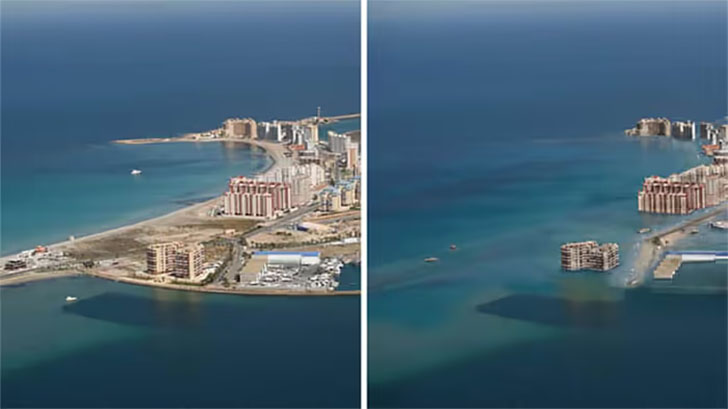
While it may have lost some of its pristine charm, La Manga still beckons with its Mediterranean allure. The past whispers of a tranquil oasis, while the present echoes with the vibrant rhythms of a seaside resort.
Muir’s Mighty Morph: Ice Giants to Watery Whispers!
Back in 1890, Muir Glacier, located in Alaska, stood as a colossal monument of ice, stretching vast and powerful across the landscape. Its frozen facade captured the imagination, symbolizing nature’s untouched grandeur. Fast forward to 2005, and the glacier told a very different tale.
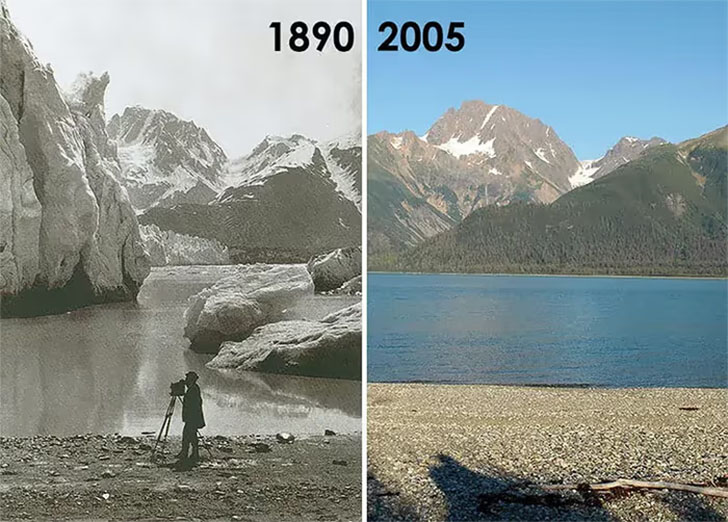
A dramatic retreat revealed vast expanses of previously submerged land, and the once-imposing ice had dwindled significantly. As years passed, Muir Glacier transformed from a frozen titan to a potent symbol of climate change, underscoring the profound and swift impact of global warming on our planet’s pristine wonders.
Flatiron: From Vintage Charm to Modern Marvel
In 1917, New York City’s Flatiron Building stood as an architectural marvel, its triangular design turning heads in a city on the brink of a skyscraper boom. Horses and carriages clattered by, and the world was amidst great change. Spin to 2012, and the Flatiron remains an iconic structure, but now surrounded by a city that never sleeps.

Modern cars, flashing billboards, and the constant hum of the digital age encapsulate it. Yet, amidst all the change, the Flatiron stands firm, bridging the gap between New York’s storied past and its electrifying present.
Lombard’s Twist: From Simple to Iconic
In 1922, Lombard Street in San Francisco was just another street, albeit with a steep incline, making its way through the city’s hilly terrain. The hustle of cable cars and Model T Fords echoed through as residents navigated daily life. Leap to 2018, and Lombard Street had transformed into “the most crooked street in the world!
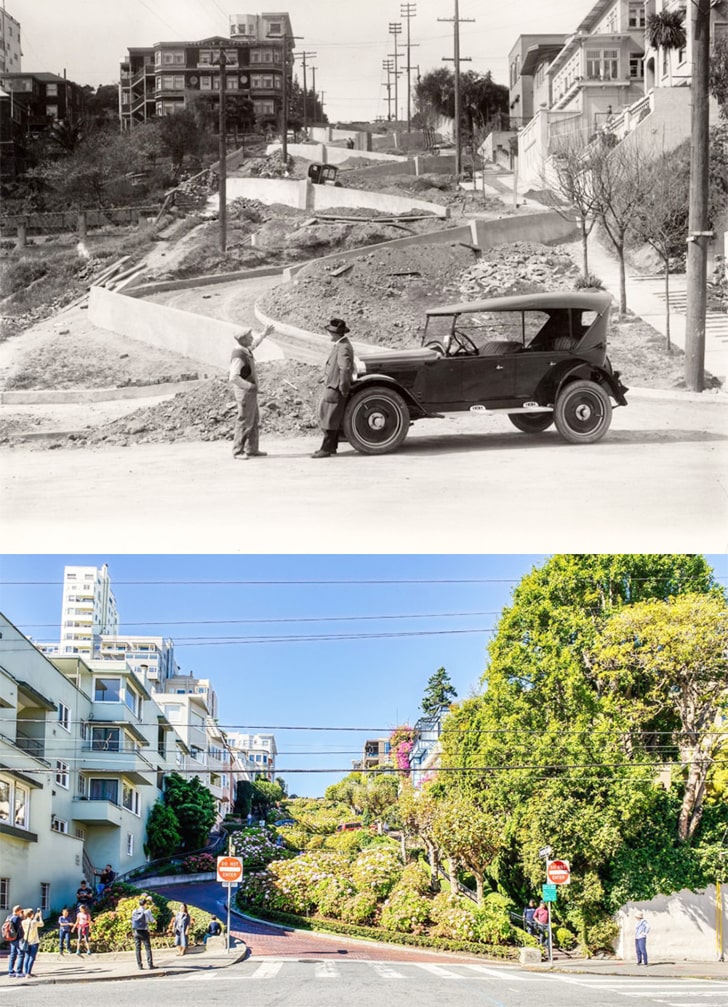
Its eight hairpin turns, beautifully adorned with blooming hydrangeas, became a magnet for tourists. Vehicles inched their way down while visitors snapped memories. From a simple city street to a worldwide attraction, Lombard’s evolution encapsulates San Francisco’s charm and flair for the unique.
Stone Faces: From Idea to Icon
In 1922, the granite expanse of Mount Rushmore in South Dakota was just a rugged mountain, untouched and without the iconic visages. Carving colossal presidential faces was still a dream in sculptor Gutzon Borglum’s mind. Flash to 2018, and Mount Rushmore had long been an emblem of American pride.
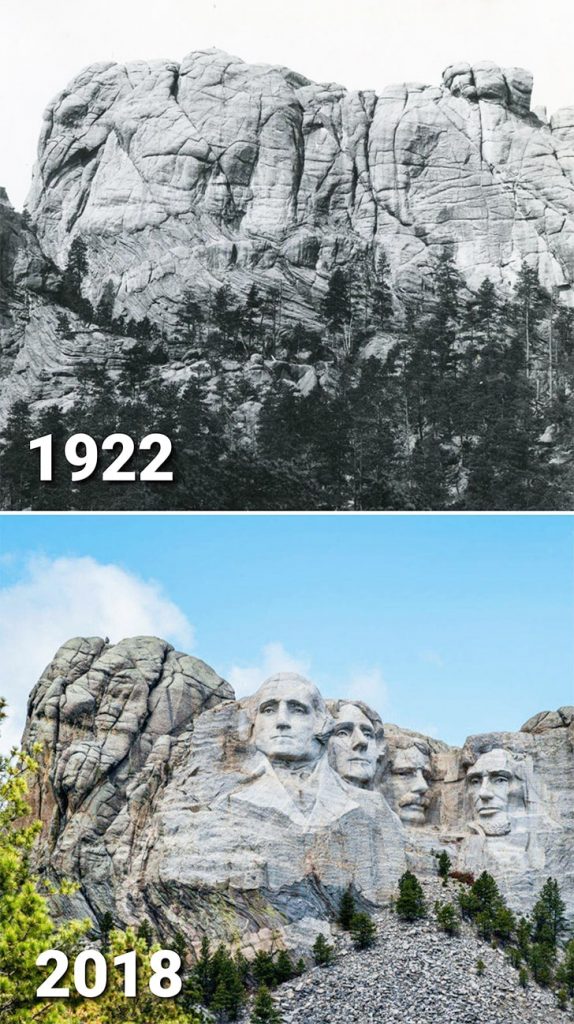
The majestic profiles of Washington, Jefferson, Roosevelt, and Lincoln gazed forth, drawing millions of tourists yearly. From a mere mountainside to a symbol of national identity, Mount Rushmore’s transformation over nearly a century is a tribute to vision, artistry, and sheer determination. A mountain turned into a masterpiece!
Chornobyl’s Echo: From Buzz to Silence!
In 1964, Chornobyl, located near the city of Pripyat in Ukraine, was abuzz with activity. It was home to a promising nuclear power plant, symbolizing the pinnacle of Soviet technological advancements. Families thrived, and the future looked luminous. But by 2011, the narrative had dramatically shifted.

Following the catastrophic 1986 nuclear accident, what once was a bustling hub became a haunting ghost town. Nature began reclaiming the land, with wildlife roaming freely amidst the remnants of human civilization. Chernobyl’s transformation from a beacon of progress to a somber reminder of nuclear perils is both unique and unforgettable.
Rio’s Radiant Rhapsody: Beaches to Carnivals
1880 painted Rio de Janeiro as an emerging jewel of Brazil. Its golden beaches were serene, and the iconic Christ the Redeemer statue hadn’t yet graced its skyline. Sugarloaf Mountain stood tall, watching over a city on the brink of cultural explosion. Zoom to the 21st century, and Rio has transformed into a carnival of colors, rhythms, and life!
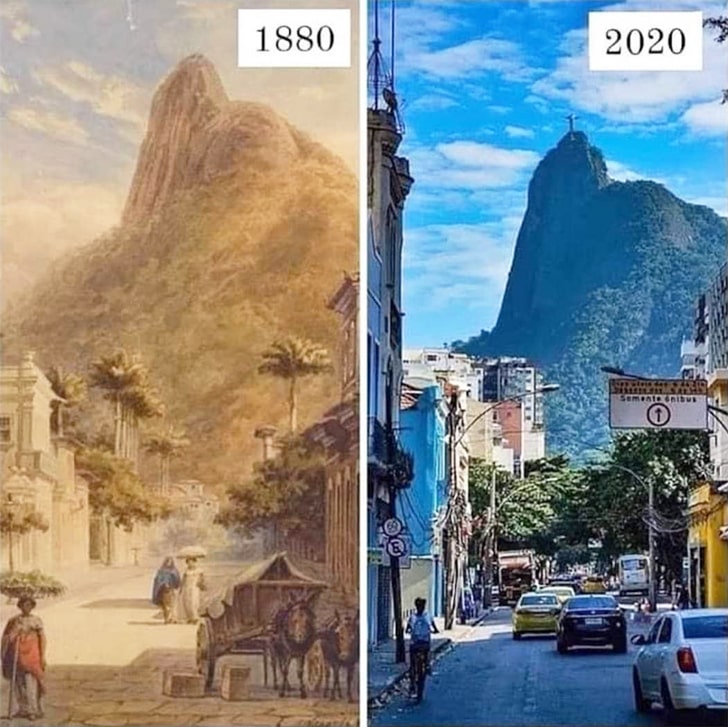
The statue now spread its arms over a city renowned for samba, football, and vibrant festivities. From quiet colonial streets to hosting the Olympics, Rio’s metamorphosis into a global hotspot is a dance of culture and human spirit. The city’s pulse? Forever infectious!
From Fresh Marble to National Symbol
In 1922, the Lincoln Memorial was a newly minted tribute, its gleaming marble portraying a contemplative Abraham Lincoln. Set against the backdrop of the Reflecting Pool, it was America’s fresh homage to its 16th president, celebrating his leadership during tumultuous times. Fast-forward to 2016, and the memorial had become more than just stone and artistry.
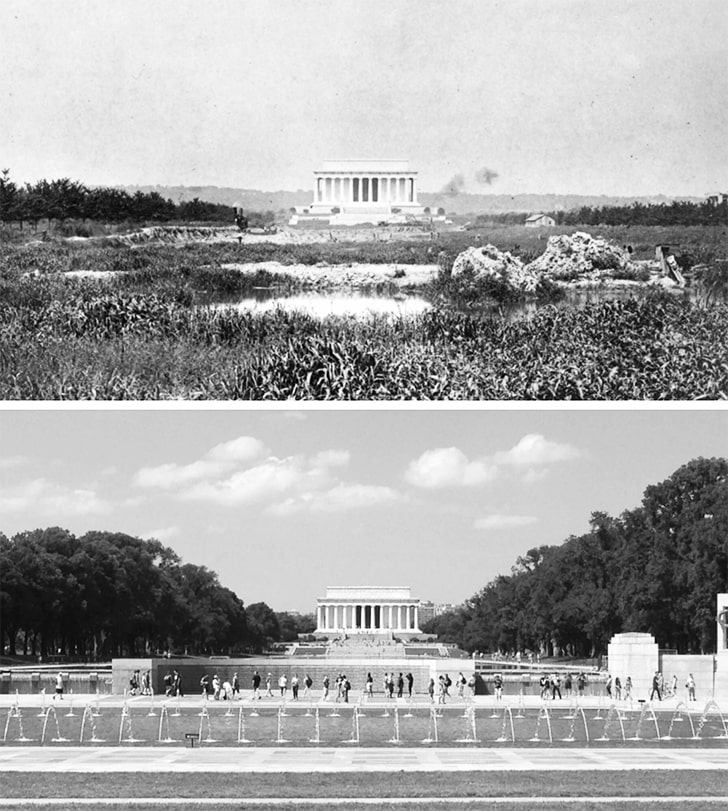
It had witnessed numerous civil rights rallies, heartfelt speeches, and countless sunrises and sunsets. Serving as a backdrop for pivotal moments in history, such as Martin Luther King Jr.’s “I Have a Dream” speech, its significance grew profoundly.
Crumbled Concrete to Symbolic Strides
1989 was a turning point for Berlin. The Wall, a stark divider of ideologies and families, was on the brink of collapse. Its graffiti-covered surface bore witness to the struggles and hopes of a divided city and nation.
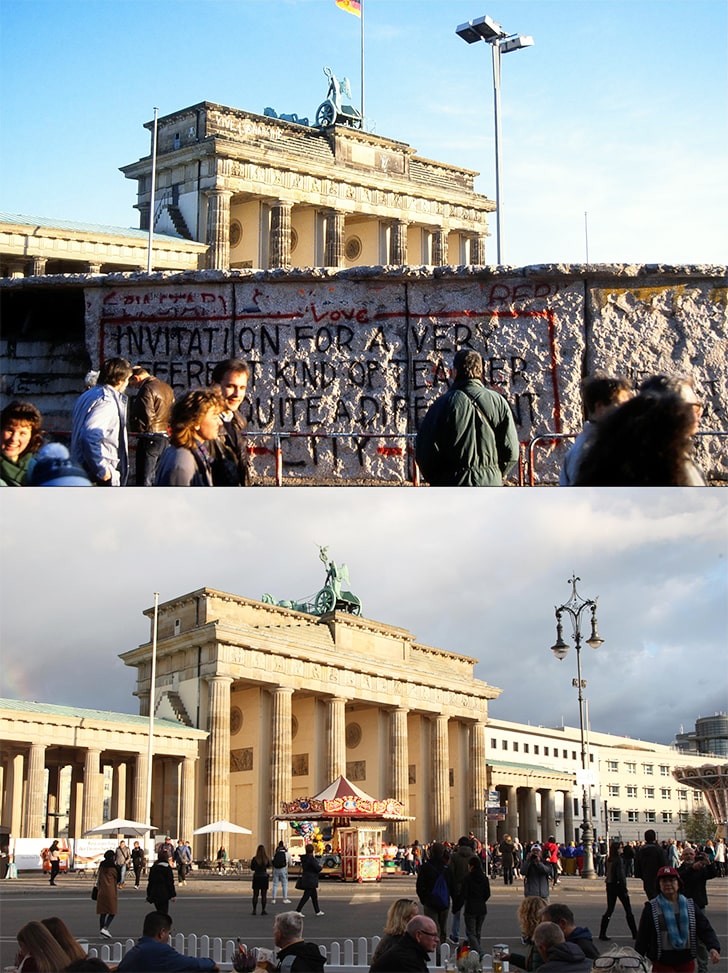
But by 2020, where the Wall once stood tall and formidable, now lay open spaces, commemorative art, and fragments preserved as historical reminders. Berlin had transformed from a city divided in two to a cosmopolitan hub, its every corner echoing stories of resilience and unity.
From Humble Beginnings to Academic Heights!
In the 1860s, the University of Montana was just an idea, a hope for higher education in the western frontier. The vast Montana landscape was largely wild, with settlers seeking new opportunities. Come 2018, and the picture was vastly different!
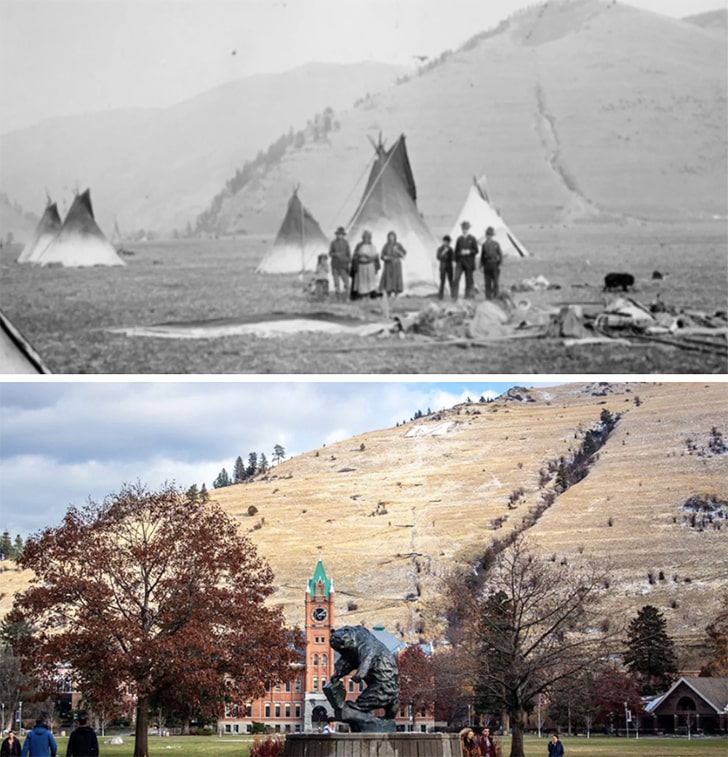
The University had blossomed into a beacon of learning, its campus sprawling with state-of-the-art facilities, diverse student bodies, and revered faculty. Its transformation from a nascent institution to a renowned hub of academia is awe-inspiring. The University of Montana’s journey is a testament to the power of education and the spirit of growth and community. What a remarkable evolution
Witnessing Time: The Big Oak’s Tale
Back in 1895, the Big Oak in Thomasville, Georgia, was already a significant landmark. With its expansive branches and towering stature, it provided shade and solace to the townsfolk, witnessing the simpler rhythms of life in a budding town.
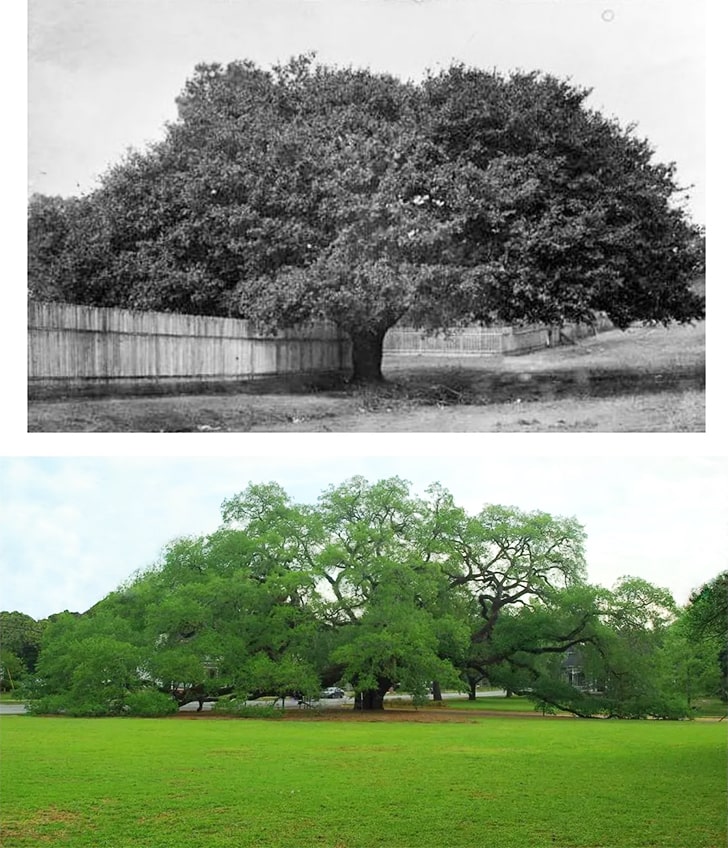
By 2020, this majestic tree had grown even grander, its boughs sprawling wide, having seen more than 330 years pass beneath its shade. Amidst the technological advancements and the bustling pace of modern life, the Big Oak stood as a serene, steadfast testament to time and endurance.
Harbor’s Hustle: Steamships to Skyscrapers
1937 witnessed New York Harbor bustling with steamships, ferries, and tugboats. The skyline was growing, but the iconic structures like the One World Trade Center were decades away. The harbor was the gateway to America, with Ellis Island welcoming hopeful immigrants dreaming of a new start. Fast forward to 2017, and the harbor had evolved dramatically.

Modern cruise liners and container ships navigated its waters while helicopters buzzed above. The skyline? A glittering spectacle of modern architecture. Yet, the Statue of Liberty still stood tall, her torch shining as a beacon of hope and freedom.
From Sleepy Shores to Sun-Kissed Metropolis
In 1927, San Diego radiated a tranquil charm. Beaches were more serene, embraced by the Pacific’s gentle waves. The city was steadily growing, yet it retained a sleepy coastal town aura, with trolleys gliding down its streets and the burgeoning Naval base setting its roots.
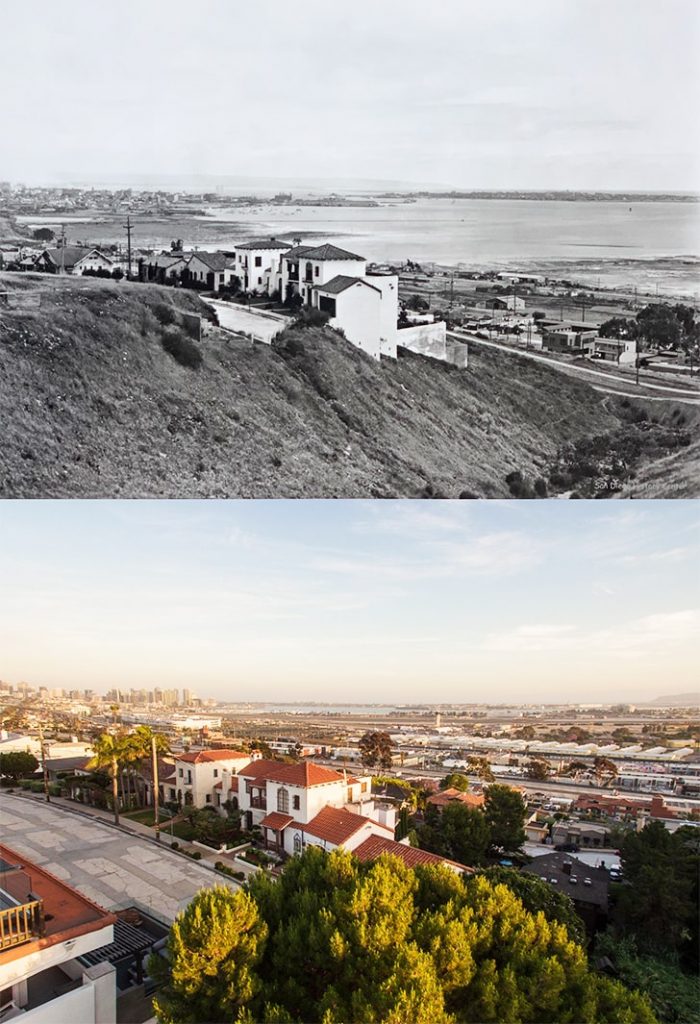
But by 2020, the city had blossomed into a thriving metropolis. Skyscrapers dotted the skyline and the buzz of tech startups mixed with the rhythm of vibrant festivals. From Balboa Park’s myriad attractions to the bustling Gaslamp Quarter, San Diego’s evolution from a quaint harbor town to a cosmopolitan coastal hub showcases its adaptive spirit.
From Narco Skies to Sunken Relic
In 1985, Pablo Escobar’s plane was a symbol of the Medellín Cartel’s power and reach, flying high and evading authorities as it transported illicit cargo across borders. A reflection of Escobar’s immense wealth and audacity, it soared through the skies, untouchable and unstoppable.

In 2020, the once-feared aircraft found its resting place submerged in the salt waters of the Bahamas. Reduced to a decaying relic, it serves as an eerie diving attraction for adventurers. Its sunken remains are a stark contrast to its former glory.
Green Sanctuaries: Century of Conservation
In 1903, the idea of national parks was budding. With a few gems like Yellowstone already designated, these parks were America’s pioneering efforts to preserve its natural wonders for generations to come. Teddy Roosevelt, awed by the grandeur of places like Yosemite, championed their conservation.
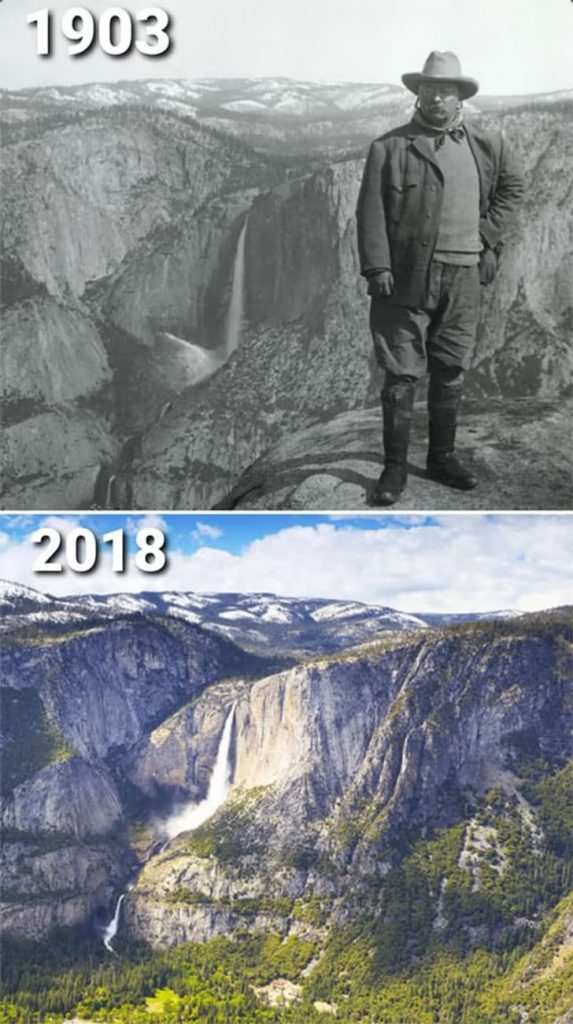
By 2018, the concept had flourished immensely. The United States boasts 60 national parks, spanning diverse landscapes from arid deserts to lush rainforests. These protected havens drew millions annually, offering escapes into nature’s raw beauty.
Prague: Century of Magic & Metamorphosis!
In 1910, Prague was a jewel in the Austro-Hungarian Empire’s crown, with its cobbled streets, Gothic cathedrals, and the iconic Charles Bridge witnessing horse-drawn carriages and gaslit evenings. The city echoed tales of Bohemian kings, alchemists, and artists. By 2020, the City of a Hundred Spires had beautifully interwoven its rich history with modern vibrancy.
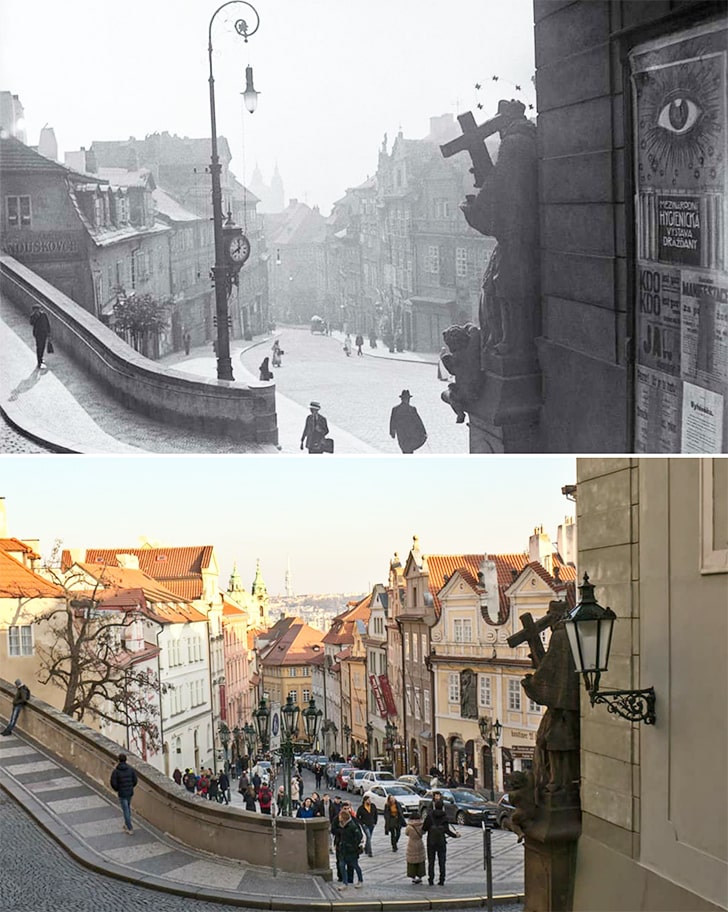
Trams now navigated streets where vintage cars once roamed, and cafes buzzed with both tales of the past and digital nomads crafting the future. Retaining its fairy-tale charm while embracing contemporary energy, Prague’s journey through a century speaks of resilience, romance, and an unyielding spirit.
From ‘Land’ Sale to Legendary Symbol
In the 1920s, the Hollywood Sign was initially “Hollywoodland” – an advertisement for a local real estate development. Nestled atop the hills, it was a beacon for potential homeowners, hinting at the glamour and allure of Tinseltown even before its cinematic dominance was fully realized.

Fast forward to 2020, and while “land” had been dropped, the sign’s significance had skyrocketed. A symbol of dreams, fame, and cinema, it stood tall overlooking a global entertainment epicenter. No longer just a sales pitch, the Hollywood Sign had evolved into an emblem of aspirations and achievements in the movie mecca.
Uelzen’s Phoenix: From Ashes to Affluence
In 1945, Uelzen’s Town Square in Germany showed the ravages of World War II. Damaged buildings and silent streets painted a picture of a town recovering from chaos. Yet, by 2021, this square had brilliantly bounced back.
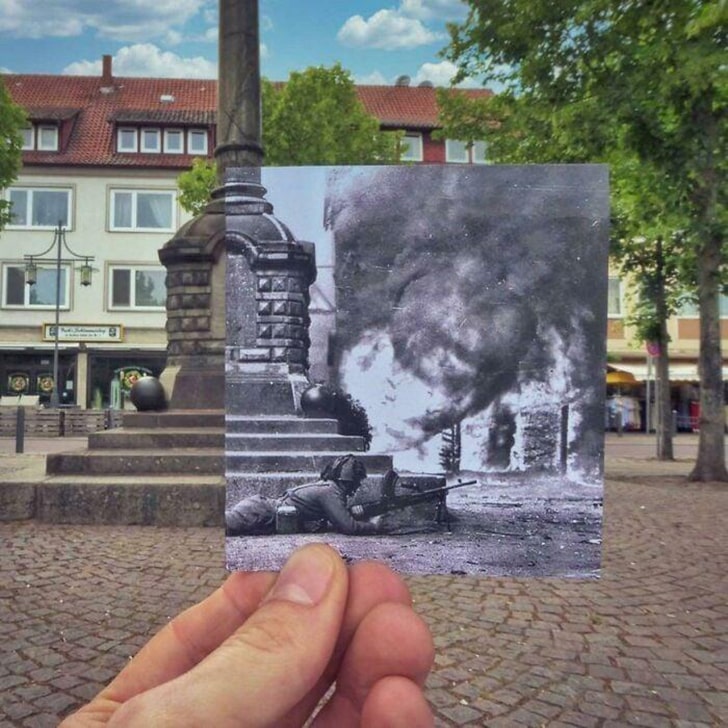
Now, vibrant cafes buzzed beside rejuvenated historic structures, and markets brimmed with activity. The blending of modern art with the town’s rich past created a harmonious fusion, turning scars into landmarks of resilience. Uelzen’s evolution from wartime wounds to modern-day vibrancy embodies the town’s indomitable spirit and its journey of rejuvenation. An emblem of endurance!
From Plows to Progress: A Century on the Farm!
In 1900, the family farm was the heartbeat of rural life. Morning rooster calls heralded dawn as families toiled together, plowing fields with horse-drawn equipment, tending to livestock, and harvesting crops by hand. Barn dances, communal gatherings, and farm-to-table meals were the essence of this life.
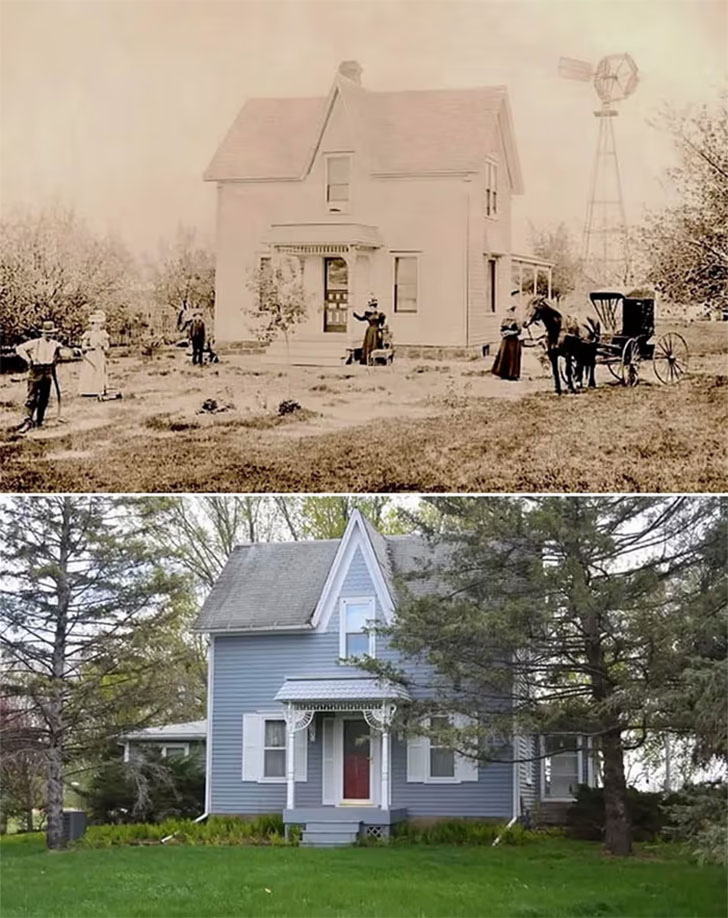
By 2000, while the heart of the farm remained, its pulse had evolved. Mechanized tractors replaced horses, technologically optimized yields, and farming became a blend of tradition and innovation. While some old barns stood witness to a bygone era, modern facilities echoed the progress of a century.
From Mail-Order Mansions to Modern Memories
In 1919, the Sears Home Kit was a revolution in homeownership. With a catalog in hand, families could literally mail-order their dream homes. These kits came with everything needed, from nails to nightstands, turning the daunting task of home-building into a doable DIY project.
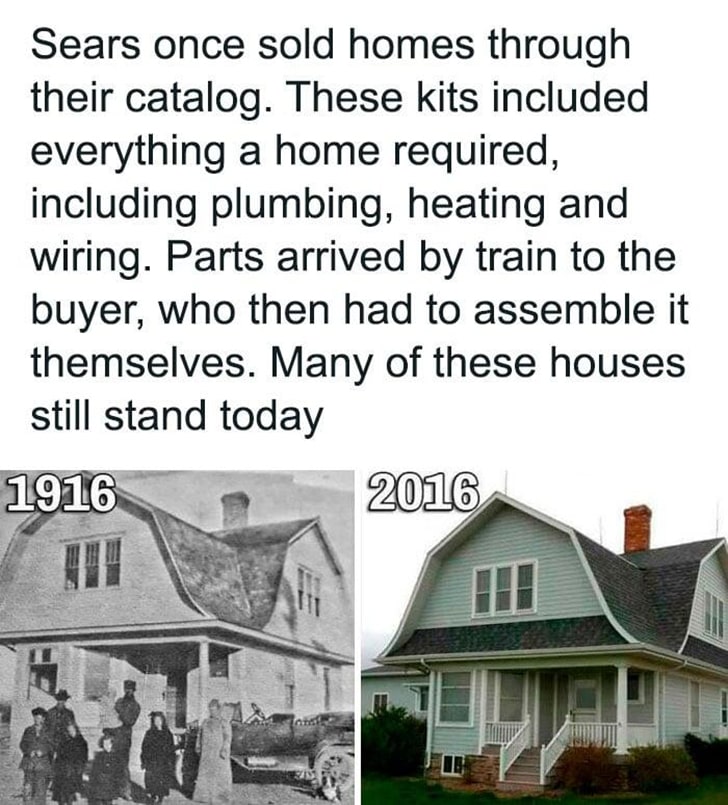
This novel approach made the American dream of owning a home accessible to many. Leap to 2016, and while Sears no longer shipped houses, the legacy of these kits lived on. Many of these homes still stood, cherished, and maintained by families who reveled in their unique history.
Distant Dwarf: Pluto’s Revealing Dance
In 1994, Pluto was a blurry enigma. Situated at the edge of our solar system, this distant celestial body was a challenge for even the most powerful telescopes, offering only vague hints about its nature. The little knowledge we had painted Pluto as just a cold, icy rock in the vast expanse of space.

Come 2019, thanks to the New Horizons spacecraft’s close flyby, the once mysterious dwarf planet unveiled its secrets. We saw a complex world with mountains, valleys, and hints of a subsurface ocean. From an indistinct speck to a geologically diverse wonder, Pluto’s evolution in our eyes showcases the strides humanity has made in space exploration.
Tavern Times: From Cozy Inn to Timeless Retreat!
In 1819, The Golden Cross Inn was a rustic haven. Situated at a crossroads, it was a beacon for weary travelers, horse-drawn carriages, and local patrons seeking solace and socialization. Its wooden beams echoed with tales of the road, and its hearth provided warmth against the chill of the night.
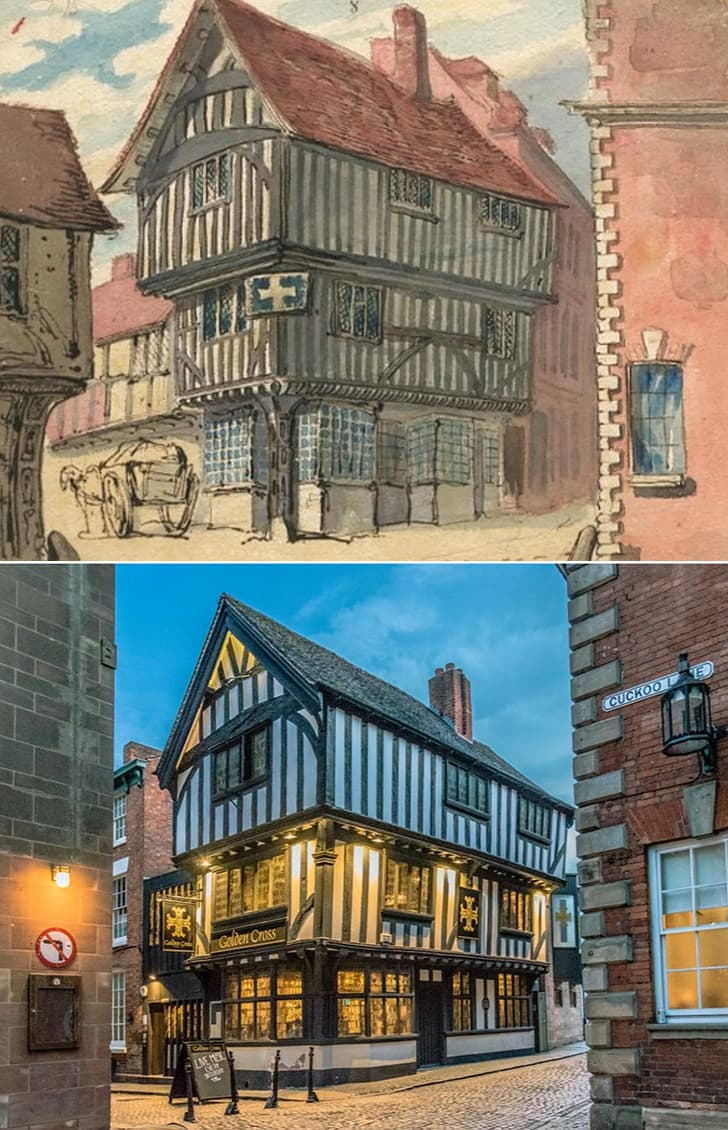
Fast forward to 2021, and while the world outside had undergone monumental changes, The Golden Cross Inn retained its quintessential charm. Modern amenities may have sneaked in, but the essence of a welcoming retreat persisted. Its walls, rich with history, continued to offer refuge and respite.
Standing Tall: Gate of Change & Celebration
In 1989, the Brandenburg Gate stood as a poignant emblem of a divided Berlin, shadowed by the Berlin Wall. It marked the chasm between East and West during the Cold War’s peak. But by 2022, its narrative had shifted dramatically. No longer a symbol of division, the Gate radiated unity and hope.

As Pariser Platz thrummed with life, tourists and Berliners gathered to celebrate events and shared histories. From a barrier’s shadow to a reunified city’s pride, the Brandenburg Gate epitomizes Berlin’s resilience and transformation. A testament to enduring unity!
Mystic Mountains: From Rediscovery to Global Adoration
In 1915, Machu Picchu was a recently unveiled secret. Hidden atop the Andean peaks, this ancient Incan citadel had just been introduced to the modern world by Hiram Bingham. Covered in thick vegetation, it whispered tales of a lost civilization, waiting to share its stories.
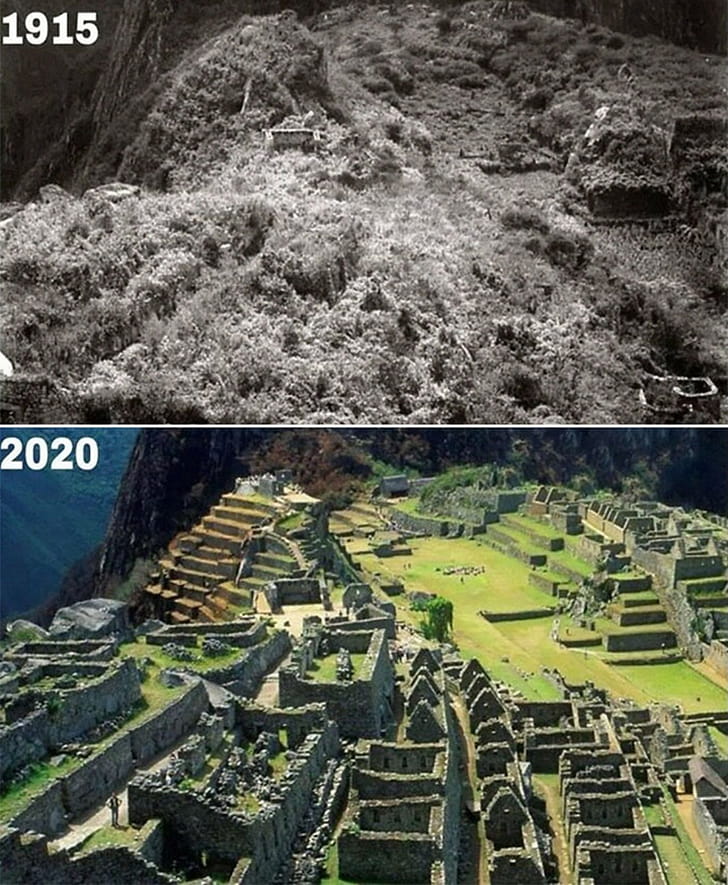
By 2020, this Peruvian marvel had become one of the world’s most iconic travel destinations. Tourists flocked from every corner of the globe to tread its stone pathways. Machu Picchu’s journey from forgotten ruins to a celebrated UNESCO World Heritage site symbolizes humanity’s endless fascination with history and mystery.
Milan Mania: From Retro Ruffles to Runway Rebels!
In the 1950s, Milan was blossoming as Europe’s heart of style and sophistication. Vintage cars roamed its streets, and cafes echoed with the chatter of fashion designers, artists, and intellectuals. The city was shaping its identity as a global fashion capital, with elegant boutiques showcasing the latest trends and haute couture.
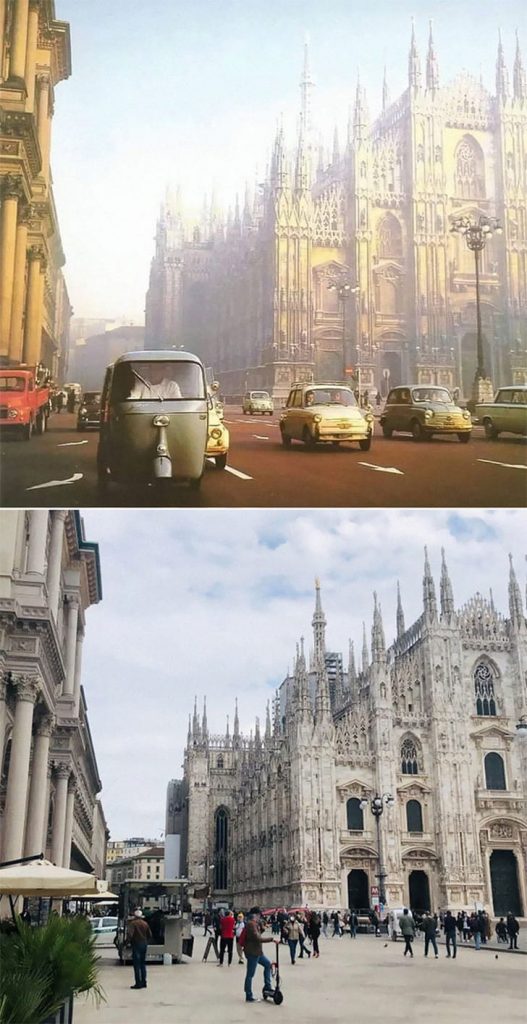
Fast forward to 2021, Milan had firmly established its spot on the world stage. Skyline-defining skyscrapers juxtaposed with historic architecture, while cutting-edge fashion weeks set global trends. From the era of classic elegance to contemporary chic, Milan’s evolution encapsulates the city’s undying passion for art, style, and innovation.
Starry Café Nights
In 1888, Vincent van Gogh’s brush danced across a canvas, capturing the enchanting ambiance of a café in Arles, France. “Café Terrace at Night” showcased a world bathed in warm yellows and cool blues. Fast forward to 2021, and this mesmerizing piece has garnered global adoration.
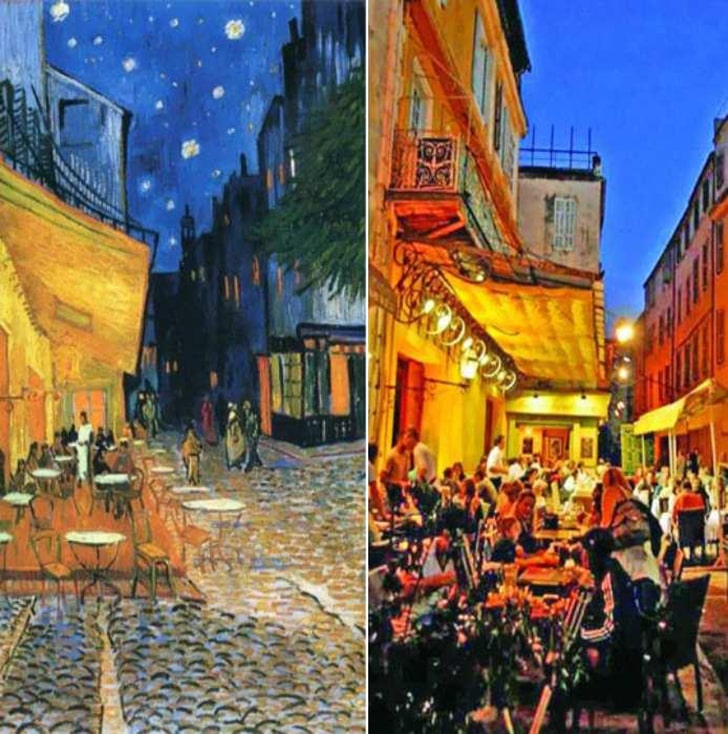
Art enthusiasts and tourists flocked to Arles, hoping to sit on that very terrace, sipping wine under the same stars. Van Gogh’s portrayal, once a personal reflection of a tranquil night, became a cultural pilgrimage for many. A painting that turned an ordinary café into an eternal evening rendezvous; It’s magically immortalized in masterful strokes!
St. Martin’s Renewal
1946 painted a poignant scene in Cologne, Germany. St. Martin’s Church, an emblem of Gothic grandeur, lay wounded – its spires shattered and stones scarred from the devastating blitz of WWII. This spiritual and architectural giant seemed to mourn its lost splendor silently.
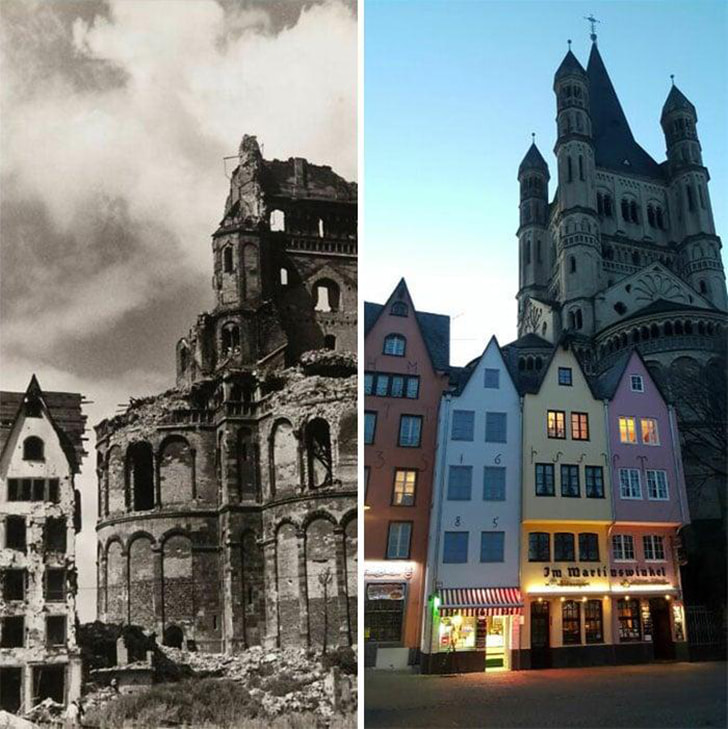
Yet, by 2021, a triumphant narrative emerged. Cologne, with unwavering resolve, had breathed life back into St. Martin. Fully restored, the church now stands tall, echoing tales of bygone eras while embracing the present. This isn’t just a story of stone and mortar but a city’s love letter to its heritage and the unstoppable march of time.
Artful Afternoons: From Elegance to Eclecticism
In the 1800s, art gallery visits were grand events. Dressed in finery, the elite admired classic oil paintings, making it as much about societal status as the art. Fast forward to the 2000s, galleries underwent a revolution.
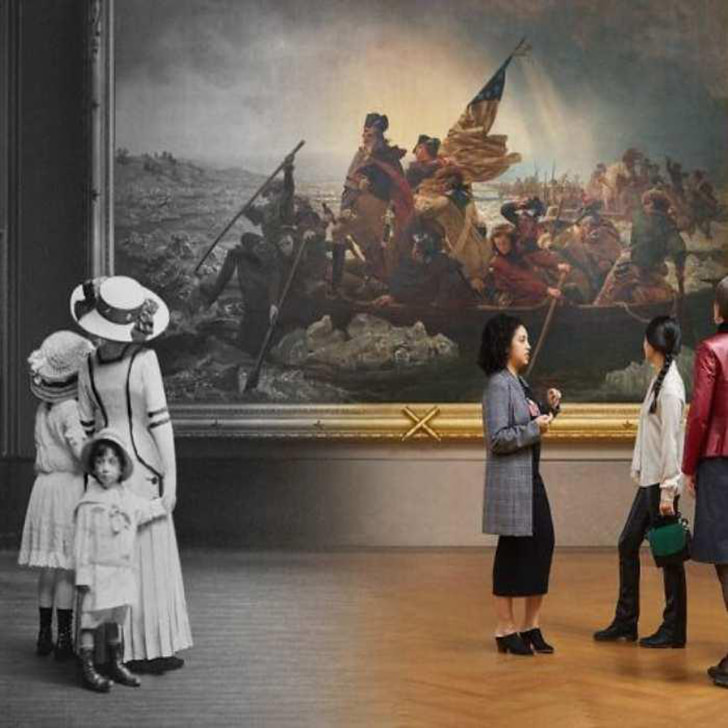
No longer reserved for a select few, they became melting pots of creativity, featuring everything from interactive installations to digital masterpieces. Visitors, diverse in attire and background, roamed freely, embracing the eclectic ambiance. It’s a vivid transformation from formal elegance to inclusive innovation!
Bath’s Time-Capsule Terrace: Royal Crescent’s Charm!”
In 1829, Bath’s Royal Crescent stood as a beacon of Georgian grandeur. Its sweeping curve housed the elite, with horse-drawn carriages gracing its facade. Fast forward to 2020, and while its iconic limestone structure remained untouched, the Crescent melded history with modern comforts.
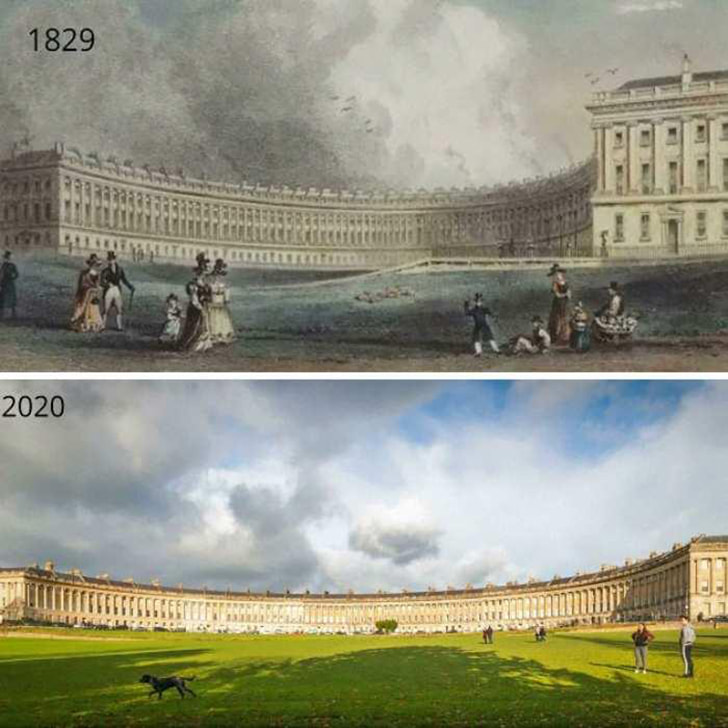
Still an architectural marvel, it drew tourists from around the world. They arrived to marvel at its timeless beauty, capturing moments amidst a backdrop that seamlessly wove the elegance of Regency England with contemporary vibes. A masterpiece through time!
Andalusian Allure: From Deserted Gem to Thriving Centerpiece
In 1840, the Court of the Lions in Granada’s Alhambra palace was a fading reflection of its Moorish splendor. While its intricate arches and the iconic lion fountain hinted at past grandeur, neglect and time had left their mark. The harmonious blend of water, architecture, and poetry was overlooked by many.
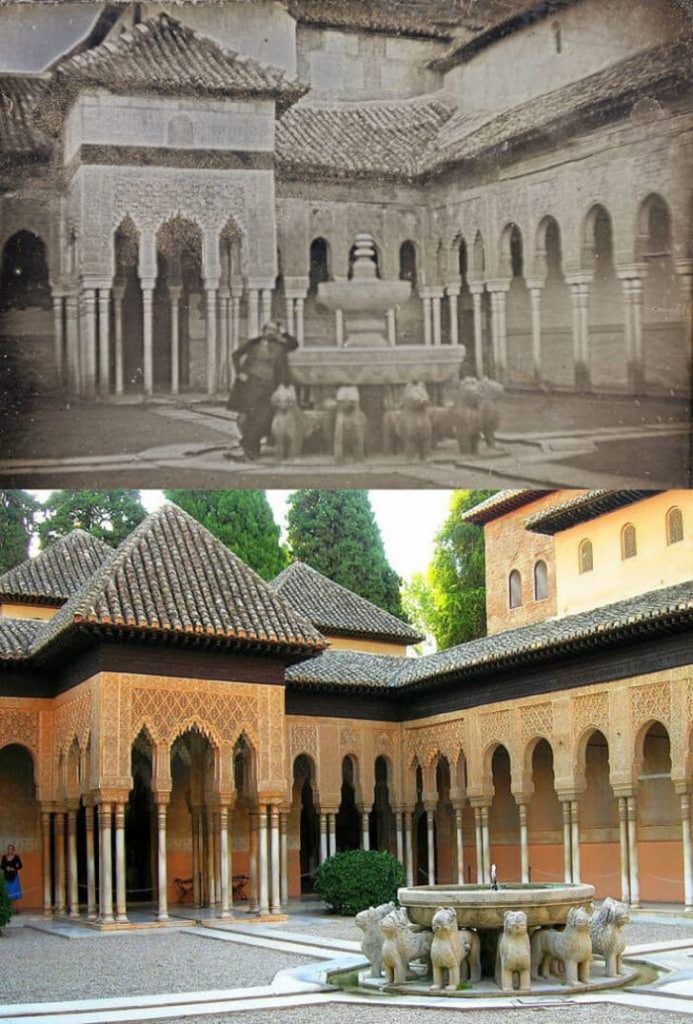
Yet, by 2021, this gem was rejuvenated. Fully restored, it stood as the heart of the Alhambra, drawing thousands to marvel at its unparalleled artistry. From a neglected courtyard to a celebrated UNESCO World Heritage site, the Court of the Lions epitomizes the preservation of Andalusian heritage.
Royal Mile: Tradition Meets Trend
In 1847, Edinburgh’s Royal Mile was alive with Victorian fervor: cobbled paths, horse carriages, and the warm hum of local taverns. Fast forward to 2021, this iconic stretch seamlessly blended its rich history with modern vibrancy.
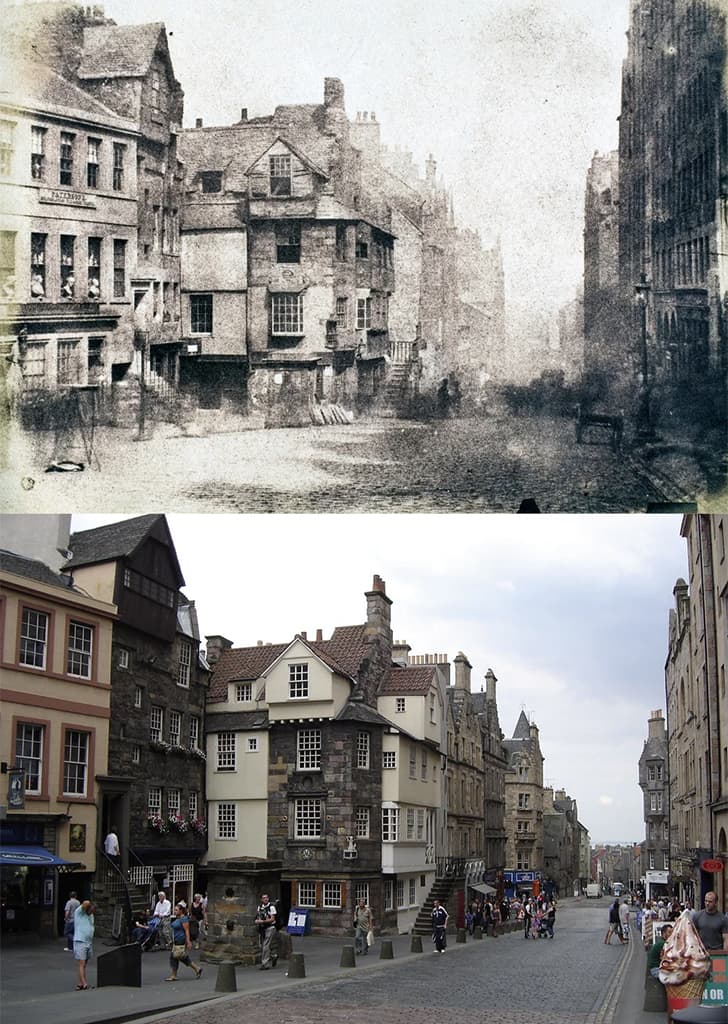
Ancient landmarks stood tall, but now amid trendy cafes and eclectic street performers. From kilted Scots discussing politics in 1847 to tourists capturing memories in 2021, the Royal Mile showcased a beautiful dance of time, where the past gracefully waltzed with the present. A Scottish tapestry ever-evolving!
Buenos Aires: Tango of Time
In 1925, Buenos Aires resonated with the soulful strains of tango played in dimly lit milongas. Tramways crisscrossed the city, and European influences shaped its architecture and culture. Fast forward to 2021, and the Argentine capital has blossomed into a cosmopolitan hub. While tango remained its heart, modern arts and tech startups began sharing the spotlight.
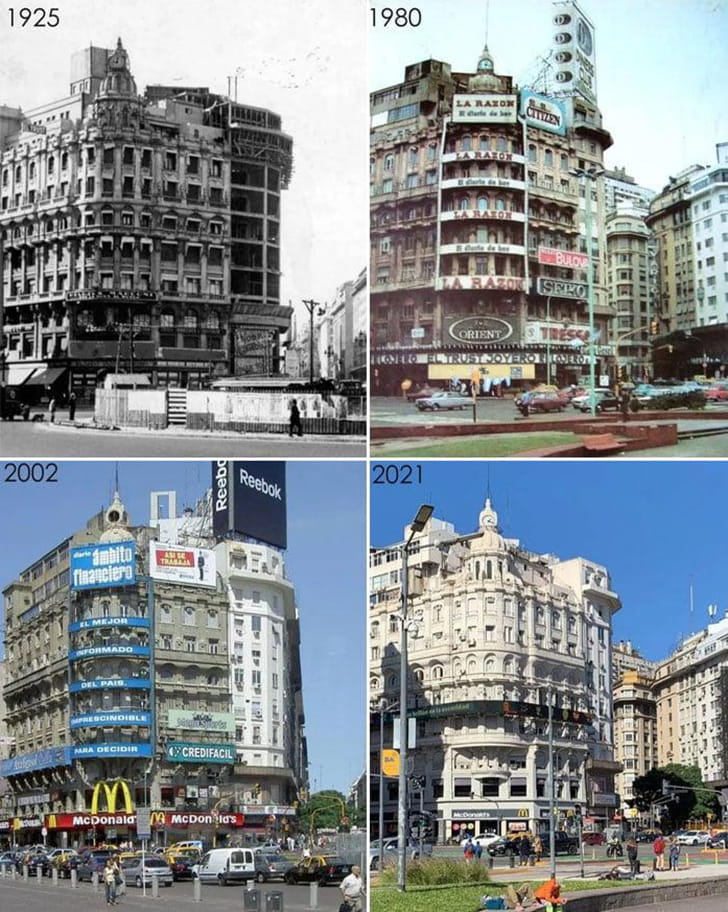
Skyscrapers mingled with historic barrios, and the culinary scene exploded with flavors. Buenos Aires, in its nearly century-long dance, gracefully transitioned from a young, hopeful city to a mature, multifaceted metropolis, always keeping its rhythm intact. A city in timeless cadence!
Arch of Time: Rome’s Constant Witness
1943 saw the Arch of Constantine in Rome standing tall amidst the turbulence of World War II. While battles raged on, this monument silently echoed tales of ancient triumphs. By 2021, surrounded by the bustle of modern Rome, this majestic arch continued to mesmerize.
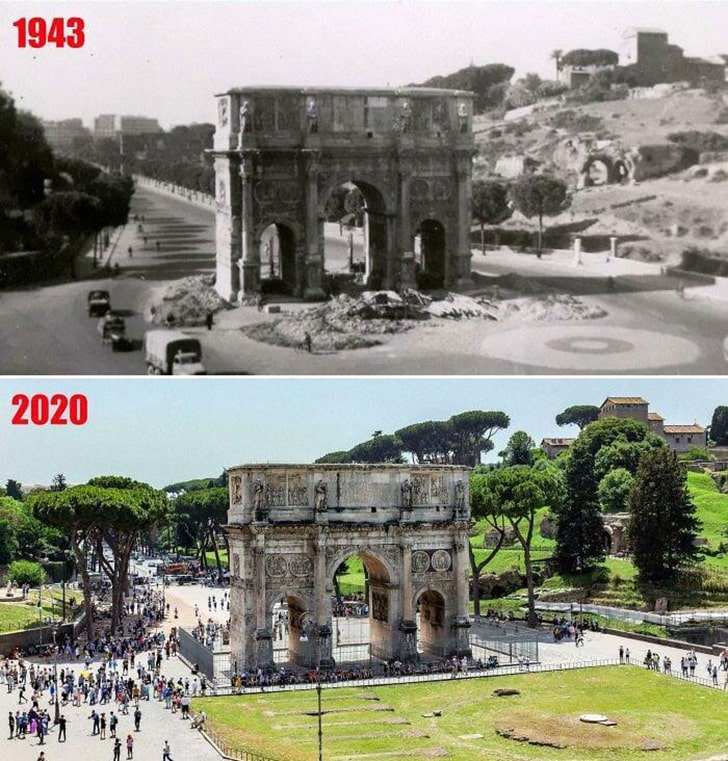
Tourists flocked, capturing selfies against its millennia-old reliefs, while the city’s scooters zipped past. From an era where it overlooked wartime strategies to a time when it anchored Rome’s tourist trail, the Arch of Constantine remained a steadfast symbol of resilience and glory. Rome’s enduring testimony to time’s passage and empires’ ebb and flow.
St. Francis’ Timeless Grace: Brazil’s Beacon!
In 1880, the St. Francis of Assisi Church in Brazil was a spiritual sanctuary, echoing with hymns and lit by candlelight. Its intricate Baroque architecture stood as a testament to Brazil’s deep-rooted faith and the grandeur of religious art. By 2020, while the world around it had transformed, the church remained an iconic symbol of devotion.

Towering skyscrapers and modern developments formed its backdrop, yet the church’s essence remained untouched. From the whispers of the past to the hum of the present, St. Francis of Assisi Church showcased Brazil’s enduring spiritual and architectural heritage. A bridge between epochs!
Bucharest’s Stage: Echoes of Elegance
1916 introduced Bucharest’s Outdoor Theatre as a fresh breath of cultural air. With gentle breezes as its backdrop, classical performances mesmerized audiences under the stars. Romania’s artistic soul found a haven amidst natural beauty. A century later, in 2016, this theatre had witnessed history, endured wars, and embraced change.

Now, it showcased a blend of traditional plays and contemporary arts. Digital projections met classic renditions, creating a fusion of the past and present. From its early days of European elegance to its modern embrace of global arts, the Outdoor Theatre celebrated Bucharest’s ever-evolving artistic spirit. A timeless applause!
Tivoli’s Time-Travel: From Gas Lamps to Neon Nights
In 1900, the main entrance to Tivoli in Copenhagen beckoned visitors with its charming allure. Gas lamps illuminated the path, and horse-drawn carriages delivered eager guests to Denmark’s beloved amusement park. The air buzzed with anticipation and childlike wonder.
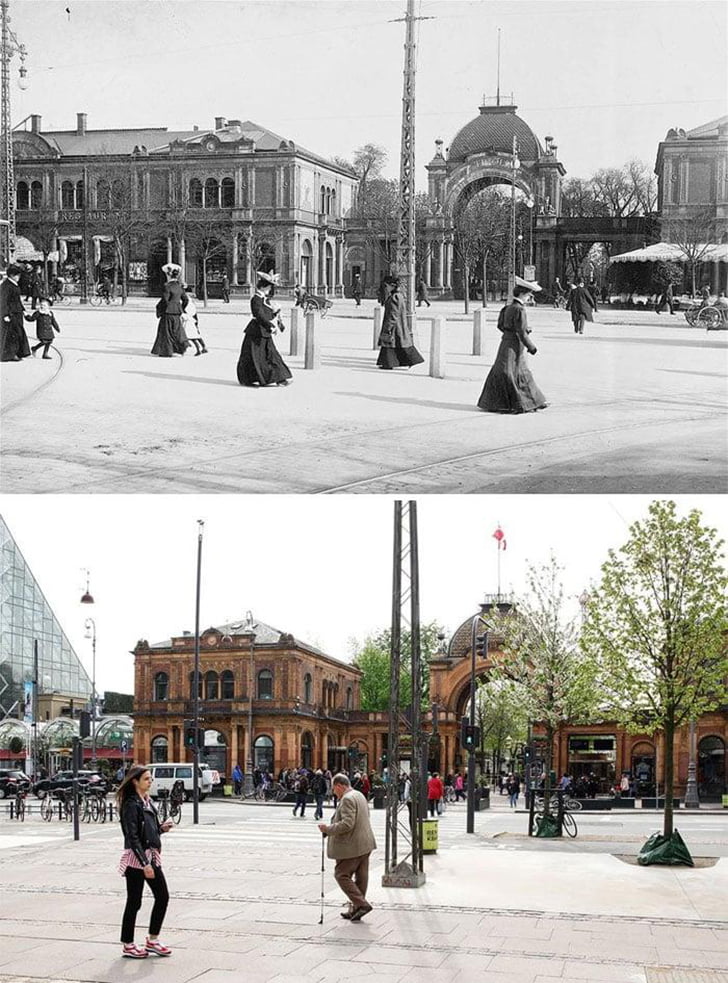
Fast-forward to 2018, and Tivoli’s entrance had evolved. Neon lights, bustling crowds, and the distant hum of modern rides set the stage. Yet, the essence of enchantment remained intact. From vintage charm to contemporary marvel, Tivoli’s gateway echoed with a century of laughter, dreams, and countless memories. Copenhagen’s heart is ever-youthful and forever inviting!
Lincoln’s Legacy: From Hearth to Heritage
1861 saw Abraham Lincoln’s Springfield home as a hub of personal and political activity. Within its walls, strategies were devised, and family memories etched. Outside, perhaps a neighbor would nod to the soon-to-be President. By 2021, the same home had transformed into a symbol of American history.
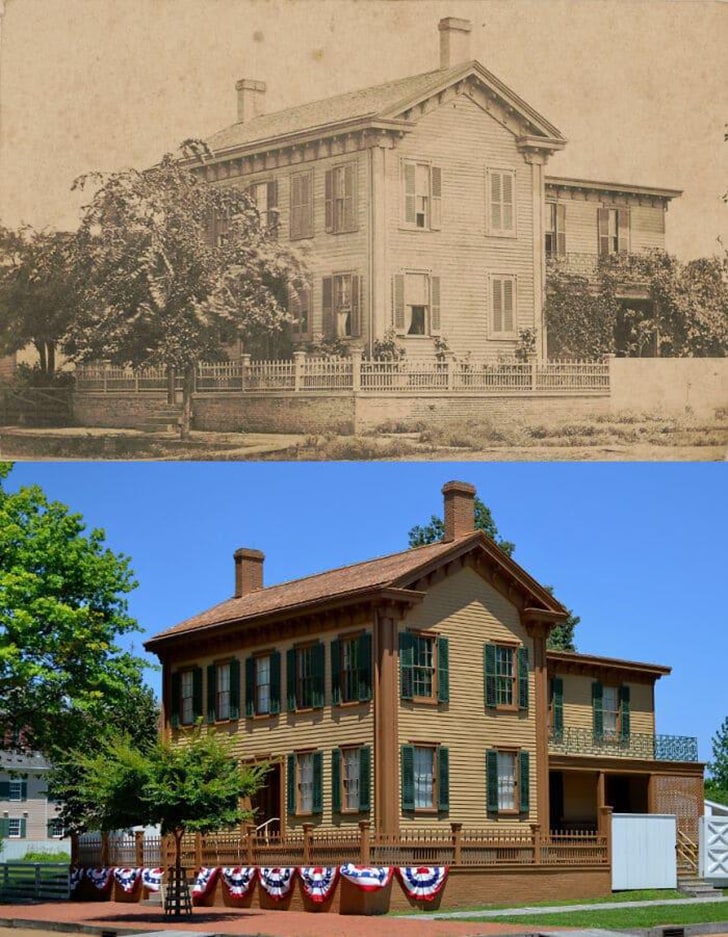
Crowds of tourists, rather than political allies, walked its halls, eager to glimpse into Lincoln’s life. While the outer facade maintained its 19th-century charm, its surroundings evolved with modern Springfield. The home not only witnessed the Lincoln family’s milestones but also stood as a beacon of America’s past, its challenges, and triumphs.
Baker Street Evolution: From Steam Hisses to Digital Bliss
1863’s Baker Street was all steam and spectacle, the heart of Victorian London’s burgeoning underground revolution. Whistles sounded, and engines roared while Londoners, in their dapper attire, embarked on their city adventures.
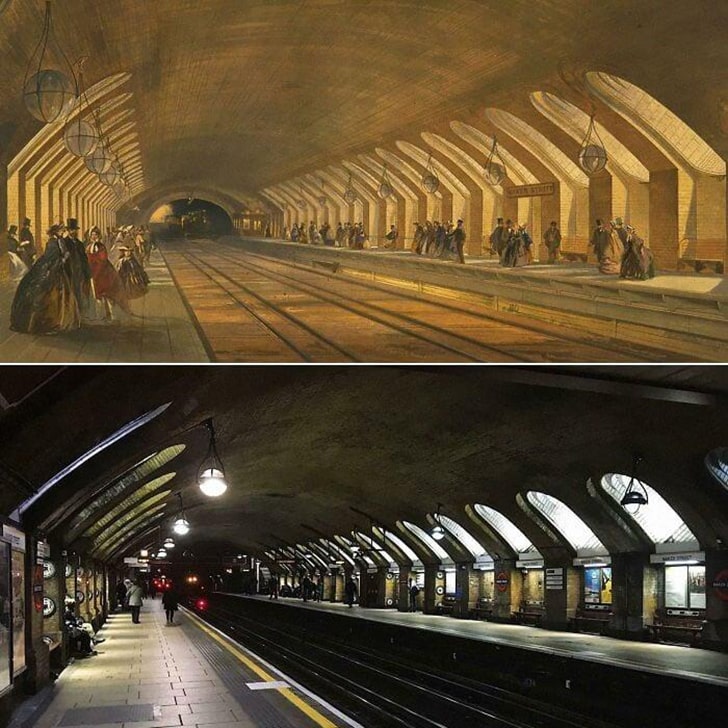
Spin to 2021, and the scene dazzled differently. Amidst historic tiles, commuters swiped smartphones, and digital displays flickered. The station, while retaining its old-world charm, buzzed with modern-day energy. Baker Street wasn’t just a station; it was a living chronicle of London’s vibrant evolution. From coal smoke to Wi-Fi signals, it’s been quite the ride!
Grand Central’s Grandeur: Whistles to Wi-Fi!”
In 1912, the Grand Central Terminal in New York City opened its doors, immediately enchanting travelers with its celestial dome and gleaming chandeliers. The clamor of shoes on marble, steam hissing from locomotives, and the hum of hushed conversations painted an era of elegance and excitement

Leap to 2021, and while the starry ceiling still awed, the terminal buzzed with modern life. Commuters dashed, electronic boards updated train schedules, and cafes served on-the-go espressos. Yet, amidst the rush, one could still feel the station’s century-old charm. Grand Centra is a timeless tapestry of New York’s hustle, history, and robust heartbeat
York’s Gateway: Echoes of Ages Past
In 1865, the City of York’s entrance stood as a testament to its medieval past. Horse-drawn carriages, cobblestone streets, and gas lamps painted a picturesque scene reminiscent of a Charles Dickens novel. It was a portal to history, whispering tales of old.

Fast forward to 2015, and the entrance to York had evolved. Modern transportation seamlessly blended with ancient walls, and while electric lights replaced gas lamps, the city’s rich history remained palpable. The timeless City of York gracefully waltzed between two eras, proving that some places, no matter how modern, always keep one foot in the past.
Manhattan’s Majestic Span: A Tale of Two Centuries!
Picture 1908: The Manhattan Bridge, newly minted, stands as an engineering marvel, connecting two New York City boroughs. With its intricate latticework and majestic towers, it promises a future of boundless possibilities for commuters and dreamers alike. By 2021, this iconic bridge has witnessed countless sunrises, sunsets, and the pulsating rhythm of the city that never sleeps.

Modern vehicles replace horse-drawn carriages, and neon city lights playfully dance on its steel. A testament to human ingenuity and resilience, the Manhattan Bridge beautifully bridges not just physical gaps but also the chapters of time, linking past visions with future aspirations.
Hong Kong’s Skyward Surge
In 1964, Hong Kong presented a fusion of East meets West, a bustling port city where junks sailed Victoria Harbour against a modest skyline. Traditional markets thrived, and colonial influences intertwined with local culture. By 2016, it was a different story. Towering skyscrapers dominated, reflecting neon lights and the city’s financial prowess.
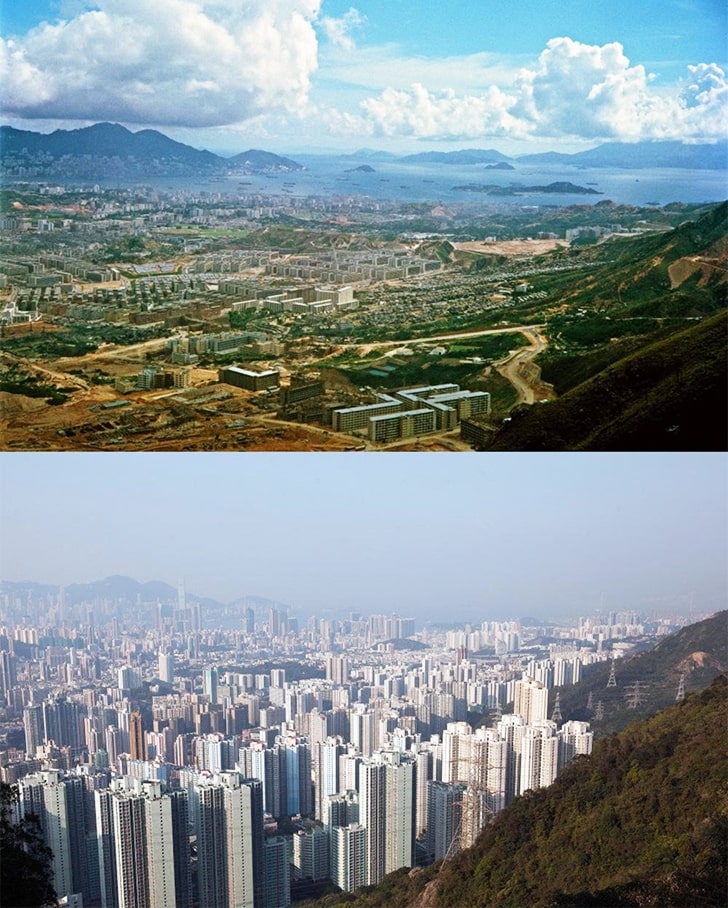
Victoria Harbour, though still iconic, was now bordered by a forest of steel and glass. From a trading port to a global financial hub, Hong Kong’s journey through the decades is a testament to its relentless spirit and adaptability, gracefully evolving while cherishing its rich heritage.
Singapore’s Sprint: Millennia Leap
In 2000, Singapore was already an impressive, modern city-state. Its skyline, punctuated by iconic structures like the Esplanade, hinted at a nation keen on innovation. The Singapore River buzzed with activity, and the Merlion stood proud. Yet, by 2016, the Lion City had further transformed.
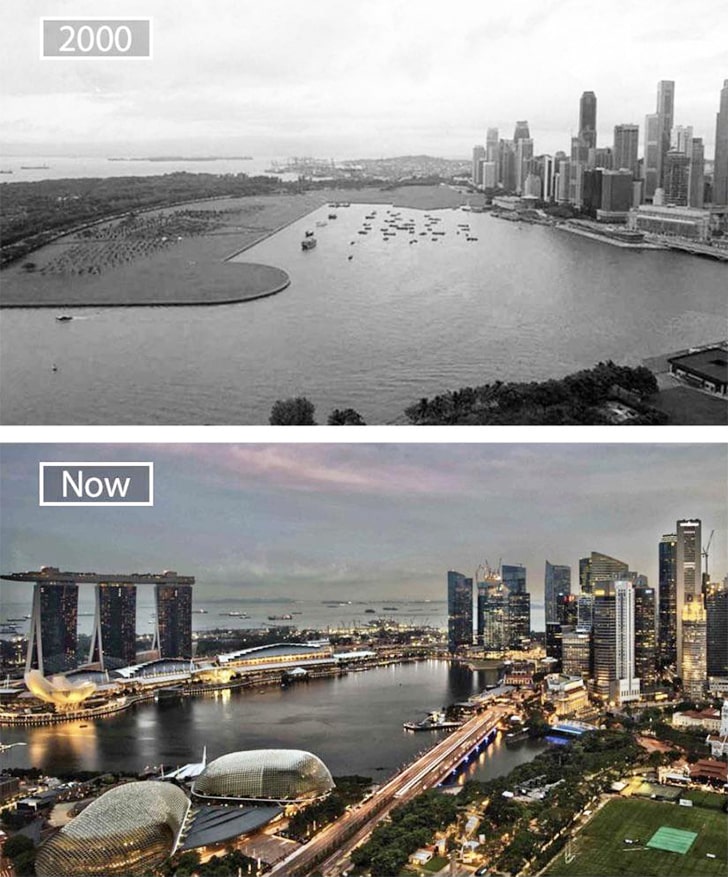
Marvels like the Gardens by the Bay and the Skytrees had risen, and the Marina Bay Sands dominated the horizon. While the core essence remained, these 16 years saw Singapore amplifying its commitment to sustainability, architecture, and world-class tourism. From the millennium’s dawn to 2016’s stride, Singapore’s metamorphosis was both rapid and resplendent.
Chicago’s Century: From Jazz to Sky-High
In the Roaring Twenties, 1926’s Chicago was ablaze with jazz, Prohibition-era speakeasies, and a growing skyline hinting at its architectural ambitions. The “Windy City” was a hub of cultural dynamism, where flapper dresses twirled to lively beats.
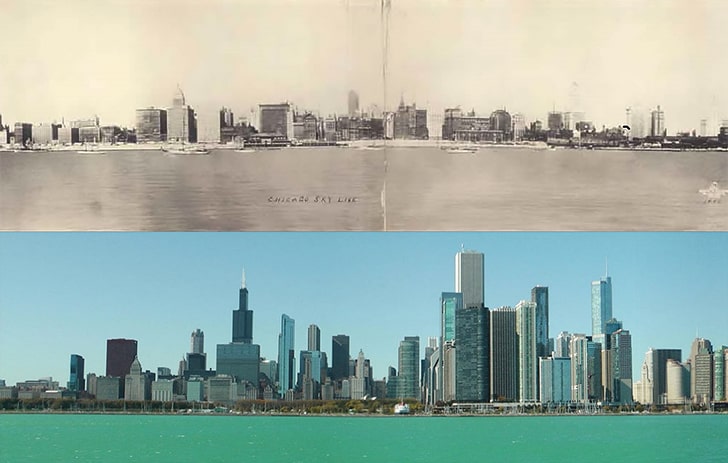
Jump to 2011, and Chicago’s magnificence was in full display. The once-emerging skyline now boasted icons like the Willis Tower. Lake Michigan’s shores witnessed a blend of historic charm and modern marvels, like Millennium Park’s Cloud Gate. From jazz-filled nights to a cityscape that reaches for the stars, Chicago’s 85-year journey is a dance of tradition and innovation.
Folsom’s Fluctuation: Waters Wane and Warnings Whisper
In 2011, Folsom Lake in California was a thriving reservoir, its waters reflecting the skies and offering recreation and sustenance to surrounding communities. Its banks were brimming, and it stood as a testament to nature’s abundance. However, by 2014, the scene dramatically changed. The lake’s water levels dropped alarmingly, revealing expanses of parched land.
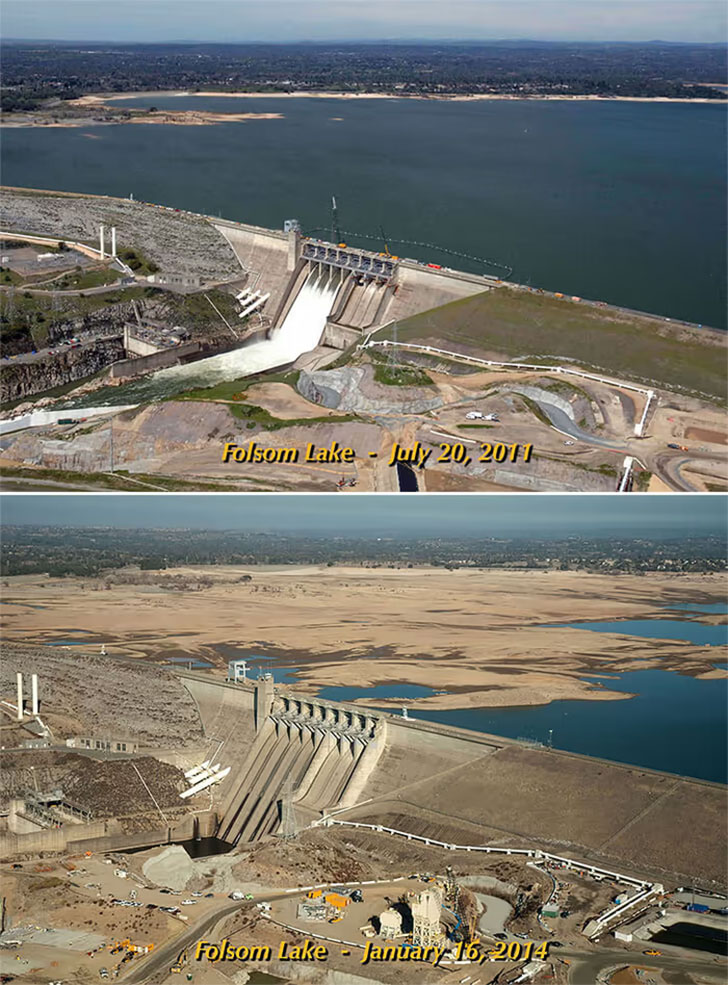
The once-bustling waterbody now echoed the harsh realities of drought and the pressing concerns of water conservation. In three years, Folsom Lake transitioned from a symbol of vitality to a stark reminder of the delicate balance of our ecosystems and the pressing need for sustainable practices.
Amazon’s Decade: Green Glory to Grim Glimpses?
In 1994, the Amazon Rainforest stood as Earth’s emerald lung, a dense canopy of green bursting with life. Jaguars roamed freely, and indigenous tribes lived harmoniously, with ancient traditions echoing through the trees. A decade later, 2004 painted a concerning picture. Patches of deforestation began to scar the landscape, a consequence of logging and agriculture.

The rich biodiversity faced threats, and the once uninterrupted verdant expanse showed signs of distress. In just ten years, the Amazon transitioned from near-pristine wilderness to a forest on the frontline, embodying the urgent call for conservation and the consequences of unchecked human intervention.
Quelccaya’s Meltdown: Ice’s Eloquent Echo
In 1983, the Quelccaya Ice Cap, nestled in the Peruvian Andes, shimmered as a vast white wonder, housing centuries of climatic history within its frozen layers. Majestic and seemingly timeless, it stood as a sentinel of the past. But by 2008, the narrative had shifted.
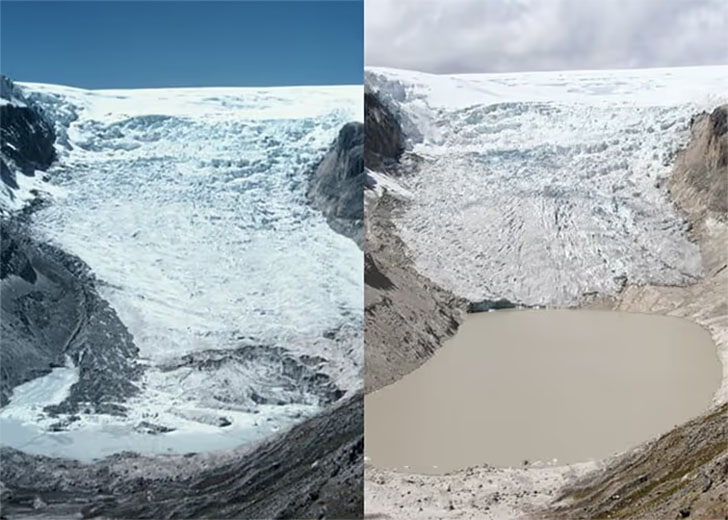
Significant portions of the ice cap had retreated, revealing stark landscapes beneath. The meltwater told tales of a changing climate, with global implications. Over 25 years, Quelccaya transformed from an icy archive to a poignant reminder of our planet’s vulnerabilities, urging us to heed its silent but pressing call for environmental mindfulness.
LA’s Century of Stardust
Step back to 1901, Los Angeles was a budding city with trolley cars navigating its streets and orange groves painting its outskirts. The glitz and glam of Hollywood were yet to take center stage. Contrast that to 2001, when Los Angeles had morphed into an entertainment capital. The orange groves were replaced by sprawling suburbs, and those trolley tracks?

Swapped for freeways buzzing with cars. The “City of Angels” had spread its wings wide, embracing change at every corner. From silent films to blockbuster movie premieres, Los Angeles’s century-long journey reflects a tale of dreams, dramas, and undeniable dynamism.
Aral’s Drastic Descent: Waters to Wastelands!
In 1973, the Aral Sea gleamed as one of Earth’s majestic inland seas, abundant with fish and anchoring lively communities. By 2009, the scene was hauntingly altered. Overzealous irrigation and mismanagement decimated its waters, leaving behind vast sandy stretches.

Once-thriving fishing hubs turned eerily silent, with stranded boats as grim relics. In mere decades, the Aral morphed from an ecological jewel to an urgent reminder of the devastating consequences of human actions on nature’s delicate balance. A sight for sore eyes!
Lake Mead’s Mirage: From Plunge to Parch
In 1983, Lake Mead, the vast reservoir behind Hoover Dam, was a testament to human engineering and nature’s bounty. Its waters stretched wide, catering to boaters, swimmers, and thirsty cities alike. Fast forward to 2021, and the lake told a different story.
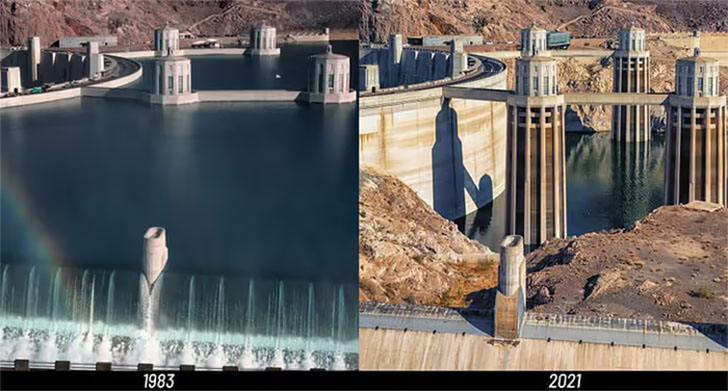
Marked by a noticeable “bathtub ring” of mineral deposits, its receding waters signaled years of drought and increased demand. The contrast between its 1983 expanse and the 2021 retreat serves as a vivid reminder of the importance of water conservation and the ever-changing dynamics of our planet’s resources amidst climatic shifts.
Capturing Time: Taylor Jones’ ‘Dear Photograph’ Project
The power of nostalgia and the art of memory came together when Canadian artist Taylor Jones initiated the “Dear Photograph” project. It all began with a simple yet profound concept: capturing a picture of someone holding up a photograph of their past in front of the place it was taken.

In this intriguing juxtaposition, the lines between then and now blur, revealing the beautifully intertwined layers of life’s journey. One of these snapshots features a dapper individual in a tuxedo, accompanied by the caption, “Dear Photograph, I looked good in a tux.”

You must be logged in to post a comment Login